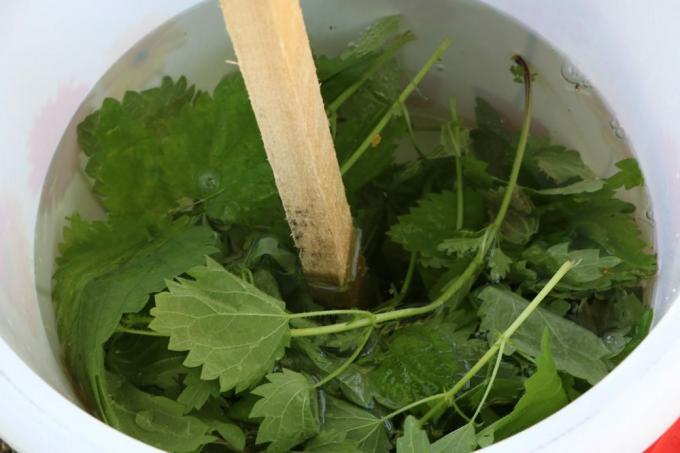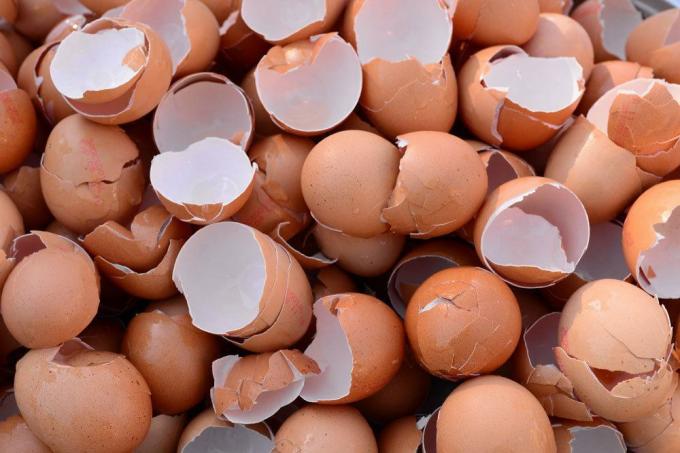
table of contents
- Water and extracts
- Herbal brews and manure
- Leftovers
- Ashes
Biological and natural fertilizers for house plants are available in every household. Alleged waste, such as leftover food, is just as suitable as weeds. The nutritional composition is important.
Home remedies provide a natural alternative to expensive products from the garden center. However, these fertilizers are not wholesome, as they are often characterized by an unbalanced nutrient composition. In order to avoid one-sided over-thinning of your indoor plants, you should combine different organic fertilizers. Research the reason for acute growth disorders in order to provide the plant with targeted support.
How often you fertilize the plants naturally varies by species. Orientate yourself to the rhythm of flowering and resting phases. All potted plants require more nutrients during flower development than during the pause in growth. Many green plants can be supplied with nutrients all year round, as long as they do not become stiff.
Tip: If you have an aquarium at home, you can use the old water for fertilization as well. The excretions of the fish provide the plants with vital nutrients in a natural way.
Water and extracts
Various ornamental plants can be fertilized with teas or boiling water. Such extracts provide a biological alternative to liquid fertilizers, which provide the plants with various nutrients directly. They are also suitable for strengthening plants and have a preventive effect against pests and fungi.
Cooking water from eggs
- - Ingredients: raw eggs
- Preparation: cook to the desired degree of doneness
- Brewing time: none, applicable after cooling
- Ingredients: calcium, potassium, phosphorus and magnesium
- Application: pour undiluted
- Effect: supplies plants with lime, is not suitable as a sole fertilizer
- suitable for: lime-loving house plants
Black tea
- Components: Leaves of the tea bush Camellia sinensis
- Preparation: pour boiled and cooled water over two to three tea bags
- Brewing time: two to five minutes
- alternative use: dry tea bags and crumble the herb on the ground
- Ingredients: minerals, trace elements, vitamins, amino acids
- Use: dilute with water before watering
- Effect: fortifying plants, against pests, with light mold infestation
- suitable for succulents and ferns

Green tea
- Components: Leaves of the tea bush Camellia sinensis
- Preparation: Pour one liter of boiled and cooled water over three bags
- Brewing time: ten minutes to an hour
- Ingredients: amino acids, vitamins, minerals, trace elements
- Use: dilute with water before watering
- Effect: improves the soil
- suitable for all indoor plants
Camomile tea
- Components: leaves and flowers of real chamomile (Matricaria recutita)
- Preparation: pour one liter of boiling water over four bags
- Brewing time: about 15 minutes
- Ingredients: chamomile oil, various acids
- Use: dilute with water before watering
- Effect: strengthens the plant and is slightly disinfectant
- suitable for young plants
Vegetable water
When vegetables are boiled and steamed, water is left over, which usually disappears unused in the drain. However, it contains numerous minerals, trace elements and vitamins. Vegetable water is therefore suitable as a natural fertilizer for green or flowering plants. The prerequisite is that the cooking water has not been salted.
Potato water
- Ingredients: potato peels
- Preparation: Simmer the bowls over medium heat for about half an hour
- Brewing time: none, can be used immediately after cooling
- Ingredients: potassium, magnesium, iron, phosphorus
- Application: pour undiluted
- Effect: improved mineral supply and against aphids
- suitable as fertilizer for flowering plants

Broccoli cooking water
- Components: stems, florets and leaves
- Preparation: Cook for at least ten minutes in boiling water so that substances pass into the cooking water
- Brewing time: none, can be used immediately after cooling
- Ingredients: potassium, calcium, phosphorus, iron, zinc and sodium
- Application: pour undiluted
- Effect: improves the stability of the plant
- suitable for flowering house plants
Asparagus stock
- Components: Sprouts and their shell
- Preparation: simmer over a medium heat for eight to 15 minutes
- Infusion time: none, can be administered immediately after cooling
- Ingredients: potassium
- Application: pour undiluted
- Effect: ensures high stability
- suitable for flowering and green plants
Onion tea
- Ingredients: 100 to 250 g leaves and peel in 5 l water
- Preparation: Pour boiling water over the ingredients
- Brewing time: ten minutes
- Ingredients: sulfur, iron, potassium, magnesium
- Use: dilute with water before watering
- Effect: helps against mites, prevents mold growth
- suitable for vigorous indoor plants
Herbal brews and manure
Different herbaceous plants are indicators of certain properties in the substrate. Nettle grows in nitrogen-rich soils, while comfrey is typical of generally heavy soils. Field horsetail, on the other hand, grows on rather poor soil and breaks down nutrients. Such plant nutrients can be extracted through infusions, because the important ingredients dissolve in the water.
Nettle
- Ingredients: 500 to 1000 g of dried herb in 50 liters of water
- Preparation: Chop the plants and pour rainwater over them
- Brewing time: about two weeks, stir regularly
- Ingredients: mainly nitrogen
- Use: dilute 1:10 or 1:20 with water before pouring
- Effect: promotes growth and stimulates chlorophyll formation
- suitable for all indoor plants

Comfrey
- Ingredients: 500 to 1000 g of dried herb in 50 liters of water
- Preparation: Chop the leaves and pour rainwater over them
- Infusion time: 1.5 to two weeks
- Ingredients: mainly potassium
- Application: dilute 1:10 or 1:20 with water before use
- Effect: improves the stability of the plants
- suitable for all indoor plants
Field horsetail
- Ingredients: 100 g dried plants
- Preparation: Pour one liter of water over the chopped herb
- Brewing time: 24 hours, then simmer for 30 minutes
- Ingredients: silica
- Application: Dilute the broth in a ratio of 1: 5 with water
- Effect: strengthens the plant tissue
- suitable for various flowering and green plants
Seaweed
- Ingredients: dried green and brown algae
- Preparation: pour boiling water over it
- Brewing time: about 24 hours
- Ingredients: Potash salts, nitrogen, phosphorus, magnesium
- Use: dilute with water before watering
- Effect: loosens loamy soil and improves root growth
- suitable for strongly consuming green and flowering plants
Leftovers
In the kitchen there are supposed waste products that often disappear unused in the household rubbish. Egg and banana peels or coffee grounds can be composted or used directly as a natural variant of a commercially available fertilizer. Pay attention to organic products when shopping, because they are unpolluted and prevent the entry of pesticides into the potting soil.
Eggshells
- Application: Crumble the peel and place on the ground
- Ingredients: calcium, potassium, phosphorus and magnesium
- Effect: decompose slowly and provide a stable substrate, which promotes plant growth
- suitable for lime-loving plants

Coffee grounds
- Ingredients: Set of filter coffee
- Preparation: pour hot water over it
- Brewing time: about ten minutes
- Ingredients: nitrogen, potassium and phosphorus
- Application: dilute one part of the broth with one part of water
- Effect: improves plant growth and chlorophyll formation
- suitable for strongly consuming ornamental plants
Bananas
- Ingredients: 100 grams of organically grown banana peel
- Preparation: chop up and boil with a liter of water
- Brewing time: about twelve hours
- Ingredients: mainly potassium, also magnesium and phosphate
- Use: dilute one part of the broth with five parts of water
- Effect: strengthens plant growth and improves flowering
- suitable for very consuming flowering plants
Old mineral water
- Ingredients: Leftovers from almost empty bottles
- Ingredients: minerals
- Application: use undiluted for watering
- Effect: good energy supplier
- suitable for all indoor plants
Leftover beer
- Components: stale leftovers
- Ingredients: potassium and sodium
- Use: mix one part beer with two parts water and administer a maximum of two times a week
- Effect: regulates the water balance in the plant and strengthens the cell tissue, promotes plant growth
- suitable for green plants
Coconut shells
- Preparation: cut into small pieces
- Ingredients: lignin and cellulose
- Application: work into the substrate or mix with soil when repotting
- Effect: stores moisture and slowly decomposes into humus
- suitable for all ornamental plants, especially for cuttings

Skimmed milk
- Ingredients: Remnants of low-fat and homogenized milk
- Ingredients: sodium, potassium, calcium, phosphorus, magnesium and iron
- Application: dilute with water (1:10) before watering
- Effect: strengthens the tissue and protects against fungal diseases or pests
- suitable for flowering plants and ferns
Tip: A glass of whole milk helps with acute stunted growth. Water your plant with the undiluted fertilizer.
Ashes
If you want to use the leftovers from the chimney as natural fertilizer, you should know the composition of the potting soil well. The residues contain large amounts of lime and are very basic. Orchids and other plants that rely on a more acidic pH value should not be fertilized with ash.
Wood ash
- Components: burnt remains of untreated wood and unprinted paper
- Ingredients: potassium, lime, phosphate and iron
- Use: sprinkle some ash on the ground
- Effect: quickly available nutrients, lime binds substrate crumbs
- suitable for lime-loving house plants
Note: Cigarette ash is not suitable as a fertilizer because it contains only about one percent potassium but a lot of toxic soot and heavy metals.
